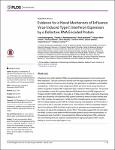Evidence for a Novel Mechanism of Influenza Virus-Induced Type I Interferon Expression by a Defective RNA-Encoded Protein
Boergeling, Yvonne
Rozhdestvensky, Timofey S.
Schmolke, Mirco
Resa-Infante, Patricia
Robeck, Thomas
Randau, Gerrit
Wolff, Thorsten
Gabriel, Gülsah
Brosius, Jürgen
Ludwig, Stephan
Influenza A virus (IAV) defective RNAs are generated as byproducts of error-prone viral RNA replication. They are commonly derived from the larger segments of the viral genome and harbor deletions of various sizes resulting in the generation of replication incompatible viral particles. Furthermore, small subgenomic RNAs are known to be strong inducers of pattern recognition receptor RIG-I-dependent type I interferon (IFN) responses. The present study identifies a novel IAV-induced defective RNA derived from the PB2 segment of A/Thailand/1(KAN-1)/2004 (H5N1). It encodes a 10 kDa protein (PB2∆) sharing the N-terminal amino acid sequence of the parental PB2 protein followed by frame shift after internal deletion. PB2∆ induces the expression of IFNβ and IFN-stimulated genes by direct interaction with the cellular adapter protein MAVS, thereby reducing viral replication of IFN-sensitive viruses such as IAV or vesicular stomatitis virus. This induction of IFN is completely independent of the defective RNA itself that usually serves as pathogen-associated pattern and thus does not require the cytoplasmic sensor RIG-I. These data suggest that not only defective RNAs, but also some defective RNA-encoded proteins can act immunostimulatory. In this particular case, the KAN-1-induced defective RNA-encoded protein PB2∆ enhances the overwhelming immune response characteristic for highly pathogenic H5N1 viruses, leading to a more severe phenotype in vivo.
Dateien zu dieser Publikation
Keine Lizenzangabe
Verwandte Publikationen
Anzeige der Publikationen mit ähnlichem Titel, Autor, Urheber und Thema.
-
2007-05-25ZeitschriftenartikelFepA- and TonB-dependent bacteriophage H8: receptor binding and genomic sequence. Rabsch, Wolfgang; Ma, Li; Wiley, Graham; Najar, Fares Z.; Kaserer, Wallace; Schuerch, Daniel W.; Klebba, Joseph E.; Roe, Bruce A.; Gomez, Jenny A. Laverde; Schallmey, Marcus; Newton, Salete M. C.; Klebba, Phillip E.H8 is derived from a collection of Salmonella enterica serotype Enteritidis bacteriophage. Its morphology and genomic structure closely resemble those of bacteriophage T5 in the family Siphoviridae. H8 infected S. enterica ...
-
2005-06-20ZeitschriftenartikelViral promoters can initiate expression of toxin genes introduced into Escherichia coli Lewin, Astrid; Mayer, Martin; Chusainow, Janet; Jacob, Daniela; Appel, BerndBackground: The expression of recombinant proteins in eukaryotic cells requires the fusion of the coding region to a promoter functional in the eukaryotic cell line. Viral promoters are very often used for this purpose. ...
-
2013-08-08ZeitschriftenartikelCytomegalovirus Downregulates IRE1 to Repress the Unfolded Protein Response Stahl, Sebastian; Burkhart, Julia M.; Hinte, Florian; Tirosh, Boaz; Mohr, Hermine; Zahedi, René P.; Sickmann, Albert; Ruzsics, Zsolt; Budt, Matthias; Brune, WolframDuring viral infection, a massive demand for viral glycoproteins can overwhelm the capacity of the protein folding and quality control machinery, leading to an accumulation of unfolded proteins in the endoplasmic reticulum ...

